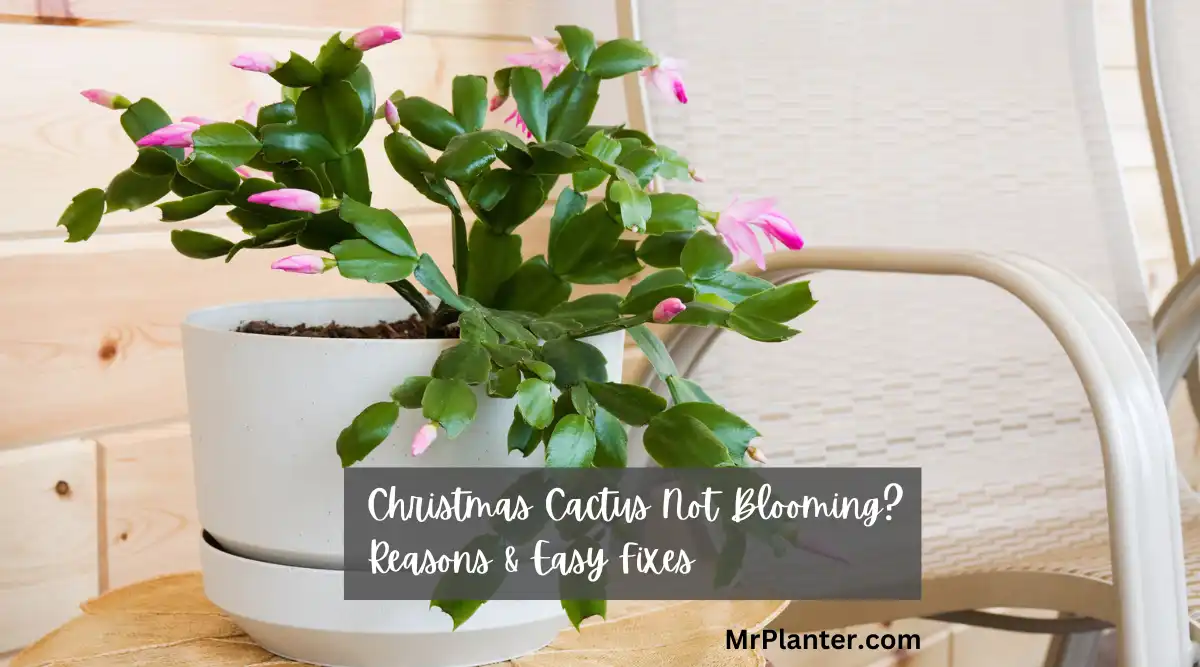If your Christmas cactus is not blooming, you may be wondering what’s going on. Despite their reputation for beautiful blooms, these plants can be finicky and may require some extra care to produce flowers.
In this article, we’ll explore the most common reasons why Christmas cacti are not blooming and provide simple solutions to help your plant thrive and produce stunning blossoms.

Whether you’re a seasoned plant owner or new to the world of Christmas cacti, we’ve got you covered with expert tips and advice.
So let’s dive in and get your Christmas cactus blooming again!
Reasons why Christmas Cactus is not Blooming
Lack of Light
One of the most common reasons why your Christmas cactus might not be blooming is due to a lack of light.
Christmas cacti require bright, indirect light to bloom properly. If your plant is not getting enough light, it may not produce flowers.
Try moving your plant to a brighter location or supplementing with artificial light if necessary.
Incorrect Temperature
Christmas cacti require a cool and stable temperature to bloom properly. If the temperature is too high or fluctuating, it can cause the buds to drop or prevent them from forming in the first place.
Try to keep your plant in a location with a consistent temperature between 60-70°F.
Improper Watering
Overwatering or underwatering your Christmas cactus can also prevent it from blooming.
Overwatering can cause the roots to rot, while underwatering can cause the plant to become too dry and stressed.
Water your plant only when the top inch of soil is dry to the touch, and make sure to use well-draining soil.
Over-fertilization
Over-fertilizing your Christmas cactus can lead to an excess of nutrients that can prevent the plant from blooming.
Use a balanced fertilizer sparingly during the growing season, and avoid fertilizing during the dormant period.
Pests and Diseases
Pests and diseases can also prevent your Christmas cactus from blooming. The common pests or bugs on Christmas Cactus include mealybugs, spider mites, and scale insects.
If you notice any signs of pests or diseases, treat your plant immediately with the appropriate insecticide or fungicide.
By addressing these common issues, you can help your Christmas cactus bloom beautifully year after year.
Christmas Cactus Not Blooming Issue Fix
1. Providing Adequate Light
One of the most common reasons why Christmas cacti fail to bloom is due to inadequate light. These plants require bright, indirect light for at least six hours a day to stimulate blooming.
If your cactus isn’t getting enough light, move it to a brighter location. Avoid placing your Chrismtas Cactus in direct sunlight, which can scorch the leaves.
2. Maintaining Optimal Temperature
Christmas cacti prefer temperatures between 60 and 70 degrees Fahrenheit during the day and slightly cooler temperatures at night.
If your cactus is exposed to temperatures outside of this range, it may not bloom. Keep the plant away from drafts and heating vents, which can cause fluctuations in temperature.
3. Proper Watering Techniques
Overwatering or underwatering can also cause a Christmas cactus to fail to bloom. These plants prefer to be kept slightly moist, but not wet.
Water the Christmas Cactus only when the top inch of soil feels dry to the touch. Make sure the pot has drainage holes to prevent water from accumulating in the soil.
To Learn the right watering technique for Christmas Cactus, check this Christmas Cactus watering guide.
4. Reducing Fertilizer Use
Excessive fertilizer can also prevent a Christmas cactus from blooming. These plants only require fertilizer once a month during the growing season, which is typically from spring to early fall.
Use a balanced fertilizer with equal parts nitrogen, phosphorus, and potassium. Avoid using fertilizer during the winter months when the plant is dormant.
Check the Christmas Cactus complete fertilizing guide to know the proper fertilizer use.
Dealing with Pests and Diseases
Pests and diseases can also prevent a Christmas cactus from blooming. Common pests include spider mites, mealybugs, and scale insects.
These can be treated with insecticidal soap or neem oil. Diseases such as root rot and fungal infections can be prevented by ensuring the plant is not overwatered and has good drainage.
By following these tips, you can help your Christmas cactus bloom and thrive.
Remember to provide adequate light, maintain optimal temperature, use proper watering techniques, reduce fertilizer use, and deal with pests and diseases promptly.
Final Thoughts and Key Takeaways
Here are the key takeaways:
- Christmas cacti may not bloom due to lack of light, temperature fluctuations, overwatering or underwatering, lack of nutrients, or getting infected by pests.
- To help your Christmas cactus bloom, provide adequate light, maintain a consistent temperature, water properly, fertilize regularly, and be patient if your plant is still young.
With these simple solutions, you can help your Christmas cactus thrive and produce stunning blossoms.
